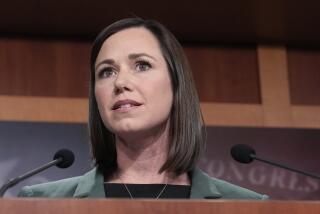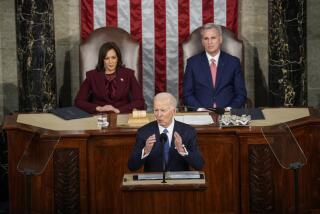Cushioning the Risks for the Old and the Young
Bill Clinton will deliver his eighth and final State of the Union address tonight. It will lack both the drama and the hype of this occasion the past two years. Clinton is now free from the threat of impeachment, free from the hope of reelection. The bridges he has not burned have been crossed, including his favorite “Bridge to the 21st century.” Yet this State of the Union address offers Clinton a genuine opportunity, a prime-time moment to begin at last the national conversation about priorities promised two State of the Union addresses ago. The question is how we as a society are to cushion the economic risks that inevitably occur, even in the most prosperous times.
The answer must embrace the children. The new century belongs to them. Until Bill Bradley spoke about the nation’s glaring gaps in health insurance coverage and children in poverty, the only income security issues that our political leaders had been willing to talk about were Social Security and Medicare. The debate has been fragmentary and partisan, responding primarily to financial concerns that are projected to become pressing once the baby boom generation begins to retire.
No sensible analysis of which age groups require greater attention to their income security could possibly conclude, as Clinton has up to now, that 77% of the next 15 years of projected budget surpluses should be devoted to programs for the elderly. About one-fourth of American children under 6 live in poverty. No one can believe that this is acceptable or bodes well for the future of the United States. Children, who are three times as likely as the elderly to be poor, have no federal entitlements program, no trust fund projections to catapult their income security needs onto the national agenda.
Everyone experiences periods out of the labor force--first as a child, then, if lucky, as an elderly adult. The United States is properly committed to providing social insurance against the risk of impoverishment in old age. Yet this tilt toward collective rather than family responsibility for retirement is hardly driven by some unvarying natural law. At an earlier time, the presumption was that adult children should support their aged parents. Today, we accept the good sense of social provision against the risk of an impoverished old age because it conforms to our understanding of the role of social protections in cushioning risks in a market economy.
Americans seem reasonably content to pay taxes to support other people’s parents, but they bridle at supporting other people’s children. To be sure, parents have a primary responsibility to support their children. Yet social protections have a larger role here than is reflected in current policy.
Because the risks of inadequate income during youth and old age are thought of differently, they are addressed in different ways and by different programs. There are practical reasons for structuring social insurance differently when responding to risks at different stages of life. The core difficulty in delivering adequate protections to children is that the virtually universal sympathy for the children is accompanied by suspicion, even antipathy, for their parents. This means that able-bodied parents must work and that benefits must be provided in-kind--health care, child care and housing, for example--rather than in cash.
Constructing a good program for particular income-security risks requires attention to a list of imperatives:
* Focus on goals. Try not to forget the basic purposes amid a host of constraints and other objectives.
* Be universal. Everyone who bears the risk should be protected and participate in financing coverage.
* Find the right functions. Arrange financing and administration so that the population called on to bear the burden can, in fact, bear it.
* Get real about costs. Assess whether a program is affordable by how much it costs in relation to its benefits, not by what budget it appears in.
* Design for durability. Legal and political arrangements must make promises that are credible, but not rigid in the face of needed change.
* Remember human nature. Maintain a clear-eyed balance between collective provision for income security and personal responsibility for economic well-being.
* Limit bureaucratic tasks and hassles. Programs must be designed to minimize information demands and controversy about eligibility or payment requirements.
Not every program can be designed to satisfy all of these conditions simultaneously. There will be trade-offs at the margin. Still, we are not caught in some set of demographic or economic dilemmas that makes security for American families beyond our reach.
The question is whether we really want to get serious about “social security,” broadly understood as our own security, the security of our neighbors, the security and durability of society itself.
More to Read
Get the L.A. Times Politics newsletter
Deeply reported insights into legislation, politics and policy from Sacramento, Washington and beyond. In your inbox three times per week.
You may occasionally receive promotional content from the Los Angeles Times.










